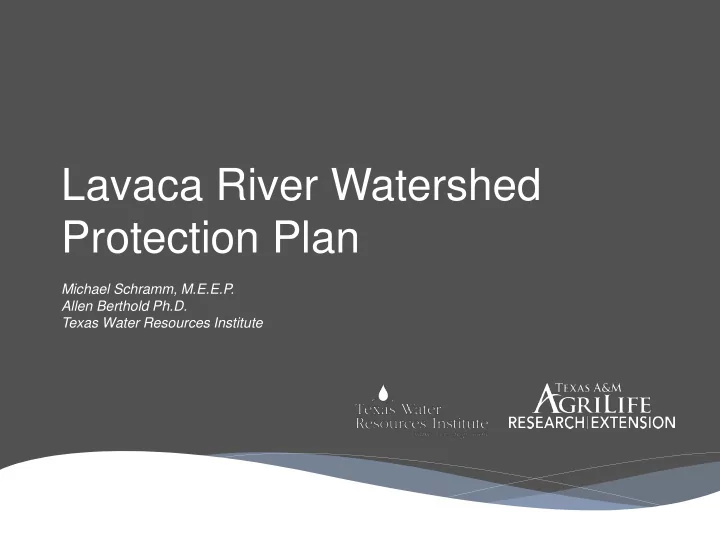

Lavaca River Watershed Protection Plan Michael Schramm, M.E.E.P. Allen Berthold Ph.D. Texas Water Resources Institute
Today Reductions needed to meet water quality standards Identify areas with highest potential to impact water quality Discuss potential management measures 2
Lavaca @ Hwy 59 Lavaca @ SH 111 Background Lavaca @ Hwy 90A ( H’ville ) Rocky Creek @ CR 387 222 cfu/100mL 115 cfu/100mL 295 cfu/100mL 3
Load Duration Curve Visualizes streamflows and pollutant loads Helps assess under what conditions pollutant loads exceed water quality standards Can use to estimate the pollutant capacity of a stream and the reductions needed 4
High Flows Moist Conditions Mid-Range Conditions Dry Conditions Low Flows 5
43% 43% 42% 42% 41% Total reduction of 7.51 x 10 13 cfu/yr 6
70% 42% No reduction needed to meet current standards 7
67% 61% 53% 46% 27% Total reduction of 3.31 x 10 13 cfu/yr 8
Summary Lavaca River Above Tidal ◉ Reduction of 7.51 × 10 13 cfu E. coli /yr to meet primary contact recreation water quality standard Rocky Creek ◉ Reduction of 3.31 × 10 13 cfu E. coli /yr to meet primary contact recreation water quality standard 9
GIS Analysis (SELECT) GIS Analysis Best Available Data Stakeholder Input Research Landowner practices NASS Local knowledge NLCD Subwatershed boundaries US Census Other Local, State, and Land Cover/ Land use Federal Datasets Soils Livestock & Wildlife Populations Human Populations Bacteria Loading Rates Total Potential Loading 10
GIS Analysis Cattle Total Potential Load ~ 1.45 x 10 17 cfu E.coli per year Assumptions: ~73,948 animal units 11
GIS Analysis Feral Hogs Total Potential Load ~ 6.03 x 10 14 cfu E.coli per year Assumptions: ~16,259 feral hogs 12
GIS Analysis Pets (Dogs) Assuming ~8,069 dogs and 40% of the dog waste may reach the stream Total Potential Load ~ 3.71 x 10 15 cfu 13
GIS Analysis OSSFs Assuming ~5,246 OSSFs and 15% failure rate Total Potential Load ~ 9.29 x 10 14 cfu 14
GIS Analysis Urban Areas and Impervious Surfaces Assuming ~35,607 acres of urban/impervious surface Total Potential Load ~ 5.10 x 10 13 cfu 15
GIS Analysis Wastewater Treatment Plants Assumes each maximum permitted discharge at 126cfu/100mL Total Potential Load ~ 1.62 x 10 10 cfu 16
GIS Analysis Summary Best Available Data Stakeholder Input Research Landowner practices NASS Local knowledge NLCD Subwatershed boundaries US Census Other Local, State, and Land Cover/ Land use Federal Datasets Soils Livestock & Wildlife Populations Human Populations Bacteria Loading Rates Total Potential Loading Livestock/Cattle ~ 1.45 x 10 17 cfu E.coli per year Pets/Dogs ~ 3.71 x 10 15 cfu E.coli per year OSSFs ~ 9.29 x 10 14 cfu E.coli per year Wildlife/Feral Hogs ~ 6.03 x 10 14 cfu E.coli per year Urbanized/Impervious Runoff ~ 5.10 x 10 13 cfu E.coli per year WWTP ~ 1.62 x 10 10 cfu E.coli per year 17
Management Recommendations 18
Livestock/Cattle Goal: 1. ◉ Minimize runoff and time livestock spend in streams Objectives: 2. ◉ Work with ranchers to develop and implement WQMPs or Conservation Plans Strategies: 3. ◉ Implement TSSWCB Water Quality Management Plans ◉ Implement NRCS Conservation Plans ◉ Deliver Education Programs and Workshop Participants: 4. ◉ TSSWCB, SWCDs, NRCS, Landowners, Lessees, AgriLife Extension, TWRI 19
Feral Hogs/Wildlife Goal: 1. ◉ Manage/reduce the feral hog population Objectives: 2. ◉ Reduce bacteria loading from feral hogs ◉ Reduce food supply available to feral hogs Strategies: 3. ◉ Promote technical and direct operational assistance to landowners for feral hog control ◉ Implement TPWD wildlife habitat management plans ◉ Deliver Feral Hog control workshops Participants: 4. ◉ AgriLife Extension, TPWD, Texas Wildlife Services, Landowners/managers/lessees, TWRI 20
On-Site Sewage Facilities Goal: 1. ◉ Reduce number of failing OSSFs Objectives: 2. ◉ Work with homeowners and communities to repair or replace failing OSSFs Strategies: 3. ◉ Identify and secure resources to repair and replace OSSF systems in targeted areas ◉ Deliver OSSF workshops Participants: 4. ◉ AgriLife Extension, County Governments/Staff, Authorized Agents, Homeowners, TWRI 21
Urbanized Areas Goal: 1. ◉ Reduce runoff and loading from urbanized areas/impervious surfaces Objectives: 2. ◉ Reduce potential bacterial loadings from pet waste ◉ Reduce stormwater runoff from impervious cover Strategies: 3. ◉ Install pet waste stations ◉ Develop and deliver educational materials to pet owners ◉ Identify potential locations, costs, resources, and types of BMPs to reduce stormwater runoff Participants: 4. ◉ TWRI, Municipal Utilities and Public Works 22
Wastewater Treatment Plants/Sanitary Sewer Overflows Goal: 1. ◉ Improve WWTP performance and reduce SSOs Objectives: 2. ◉ Reduce potential bacterial loading WWTPs where possible ◉ Reduce occurrences of SSOs Strategies: 3. ◉ Develop and deliver educational materials to residents on proper disposal of Fats/Oils/Greases and solids ◉ Identify infrastructure upgrades and replacement as funding allows Participants: 4. ◉ Municipal Utilities, TWRI 23
Other Potential Measures Source – Wildlife/White tailed deer ◉ Implement wildlife management plans Source – Illicit Dumping/Animal Carcasses ◉ Develop and deliver education programs Source – Wastewater ◉ Identify opportunities/funding to implement wastewater reuse Source – Urban Stormwater ◉ Develop municipal stormwater management plan 24
Contact Us Allen Berthold Clare Entwistle Texas Water Resources Institute Texas Water Resources Institute 979-845-2028 clare.entwistle@ag.tamu.edu taberthold@ag.tamu.edu Michael Schramm Texas Water Resources Institute 979-458-9191 michael.schramm@ag.tamu.edu
Recommend
More recommend